COLONIAL LOOTING
Stolen Nepali statue returns to its temple after decades in USAuthor: AFP|Update: 04.12.2021

Devotees carry the sculpture in a palanquin, in Patan on the outskirts of Kathmandu / © AFP
A centuries-old sculpture of two Hindu gods was re-installed at its temple in the Nepali capital Kathmandu on Saturday, nearly 40 years after it was stolen and later emerged in the United States.
The stone statue of the gods Laxmi and Narayan was repatriated to Nepal in March by the Dallas Museum of Art and the FBI after a months-long investigation by Nepali and American activists and officials.
It was taken from the temple in 1984 and appeared on display at the Dallas museum six years later, on loan from a collector.
The work, dating back to between the 12th and 15th centuries, is one of a handful of cultural artefacts returned to Nepal from foreign museums and collectors this year.
A priest chanted prayers and locals played traditional music as the statue was carried in a palanquin back to the pagoda-style temple, which was draped in marigold garlands to welcome the work.

The statue dates back to between the 12th and 15th centuries / © AFP
It was placed back on its original stone plinth, with a replica that locals had been worshipping instead moved to stand alongside.
"We are very happy. Our efforts of three to four years have been fruitful, everyone is celebrating," said Dilendra Raj Shrestha of the Nepal Heritage Recovery Campaign.
Laser sensors and CCTV cameras have now been installed in the temple to protect the statue, he added.
"We are seeing the beginning of a trend, to bring back Nepal's gods from the United States, from Europe, from other countries where they have now ended up," said the US ambassador to Nepal Randy Berry.
"I hope this is the first of many such celebrations."
Nepal is deeply religious and its Hindu and Buddhist temples as well as heritage sites remain an integral part of people's everyday lives.

The piece was placed back on its original stone plinth, with a replica that locals had been worshipping instead moved to stand alongside it / © AFP
But many sites are bereft of centuries-old sculptures, paintings, ornamental windows and even doors, which were often stolen after the country opened up to the outside world in the 1950s.
Many pieces were taken with the help of corrupt officials to feed art markets in the United States, Europe and elsewhere.
"I think there is a global change... Many countries are demanding their artefacts back and Nepal is in a great position legally because export was never permitted," said arts crime professor Erin L. Thompson.
A tweet by Thompson questioning the statue's origin and history had prompted the investigation into the sculpture.
Six pieces have been returned to Nepal this year and authorities are seeking more from France, the United States and Britain.
Why so many museums are full of stolen artefacts from Nepal and the people fighting to bring them back home
Nepalese heritage activists are campaigning to bring home some of the thousands of items stolen from temples and monasteries in the country to feed art markets
When a Nepali academic in the US saw a 17th century gold necklace from Nepal in a museum there, she wept and began to pray. ‘I had so many questions,’ she says
Agence France-Presse
Published 2 Dec, 2021
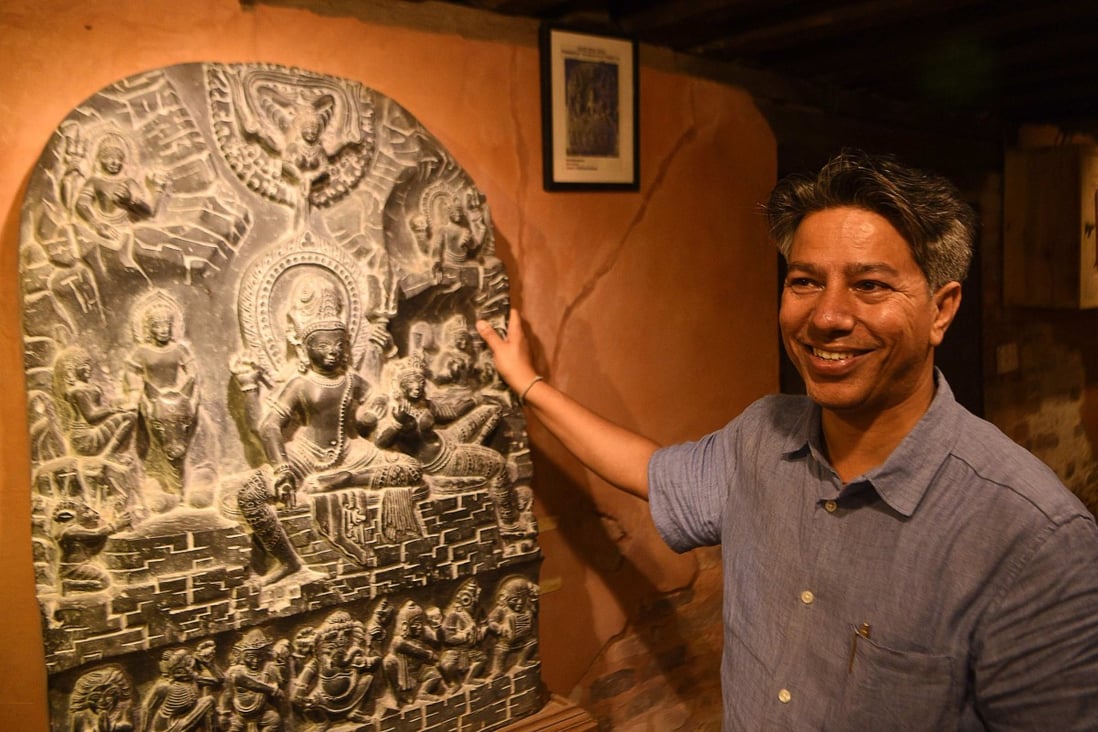
Rabindra Puri at his house in Bhaktapur, east of Kathmandu. He is one of the heritage activists campaigning to bring back from overseas museums Nepalese artefacts stolen from the country. Photo: AFP
When Virginia Tech professor Sweta Gyanu Baniya saw an ornate 17th century Nepali necklace in the Art Institute of Chicago in the United States, she burst into tears, bowed down and began to pray.
Now a video she posted on social media has made the artefact one of the latest targets for heritage activists sleuthing online to bring home some of the thousands of items whisked out over decades from the Himalayan country.
Only a handful of relics have been returned so far, but they have come from some of the world’s top cultural institutions and pressure for more is mounting.
Nepal’s then king offered the gilt copper necklace, adorned with semi-precious stones, to Taleju Bhawani, his Malla dynasty’s patron goddess, in around 1650.
‘They are gods to us’: Nepal seeks to bring home stolen artefacts from the West
Her temple in Kathmandu, the Nepalese capital, is only open to the public one day a year, but officials removed the work for safekeeping in the 1970s – after which it disappeared.
Baniya says her reaction when she visited the Chicago museum in June was “just overpowering”.
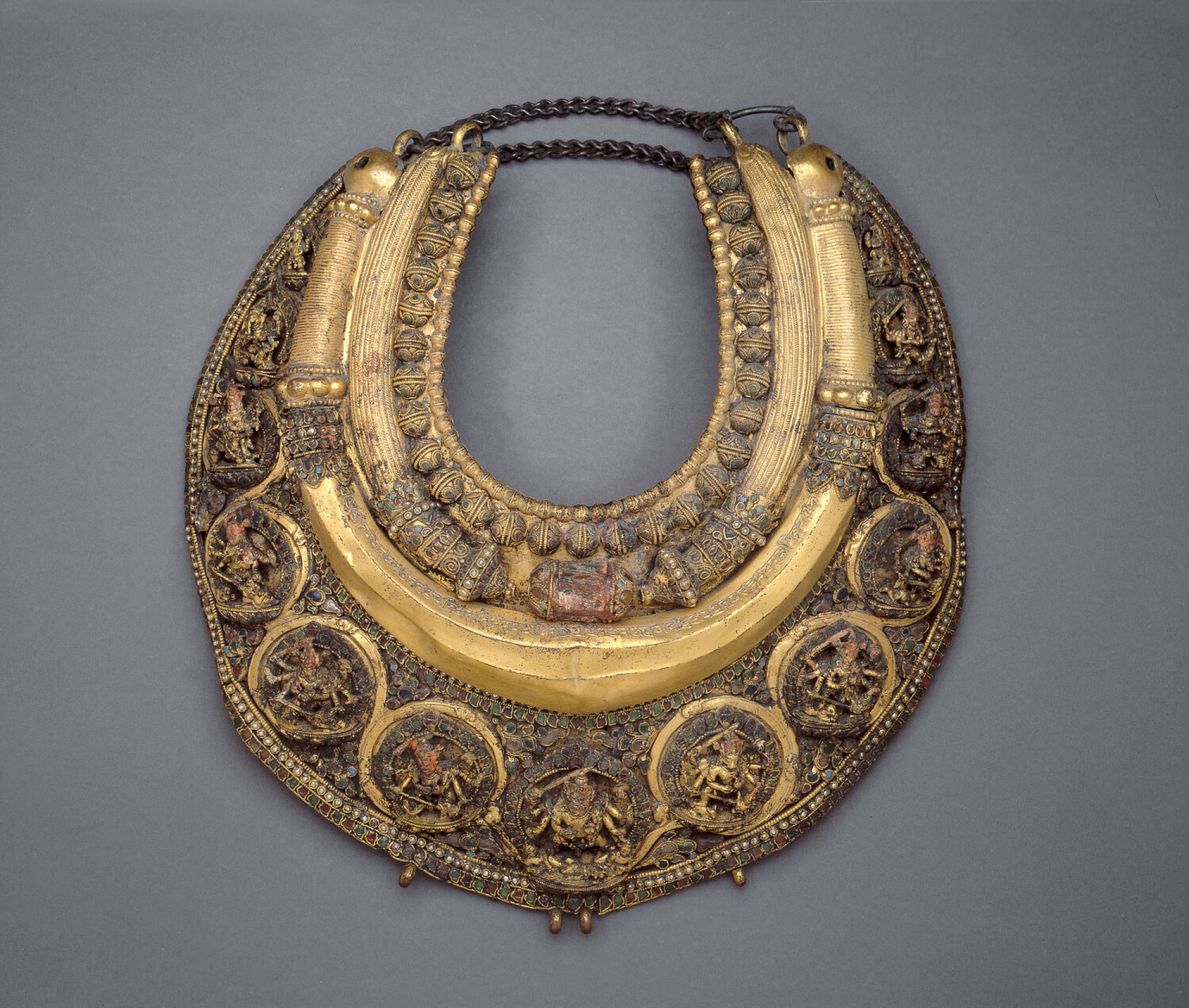
This 400-year-old necklace from Nepal is now in a museum in the United States. Photo: Art Institute of Chicago
“I started to weep in front of it,” she says. “I started to just pray normally like I would do in temple.
“I had so many questions. Like why is it here, how did it come here?”
Traces of vermilion pigment used in Hindu worship rituals are still visible on its surface, and Baniya’s Twitter video prompted Nepali authorities to contact the museum to seek its return.

Sweta Gyanu Baniya is a Virginia Tech professor. Photo: Virginia Tech
The Art Institute of Chicago did not respond to multiple requests for comment but its website states the necklace was donated by the private Alsdorf Foundation, which bought it from a California dealer in 1976.
Priest Udhav Kamacharya has served at the temple for 26 years but Baniya’s footage was the first time he had seen the relic.
As he watched, he says: “I felt that the goddess still resides here. We sometimes say the gods are not here any more, but they are. That is why it was found despite being in a foreign land.”

Priest Udhav Kamacharya has served at the Taleju Temple for 26 years. Photo: AFP
Nepal is deeply religious, and its Hindu and Buddhist temples and heritage sites remain an integral part of people’s everyday lives.
Many, though, are bereft of their centuries-old sculptures, paintings, ornamental windows and even doors, stolen – sometimes with the help of corrupt officials – after the country opened up to the outside world in the 1950s to feed art markets in the United States, Europe and elsewhere.
“Our art for us is not just art, they are gods to us,” says heritage expert Rabindra Puri, who campaigns to repatriate stolen Nepali heritage and has assembled a collection of replicas for a planned museum on the issue.
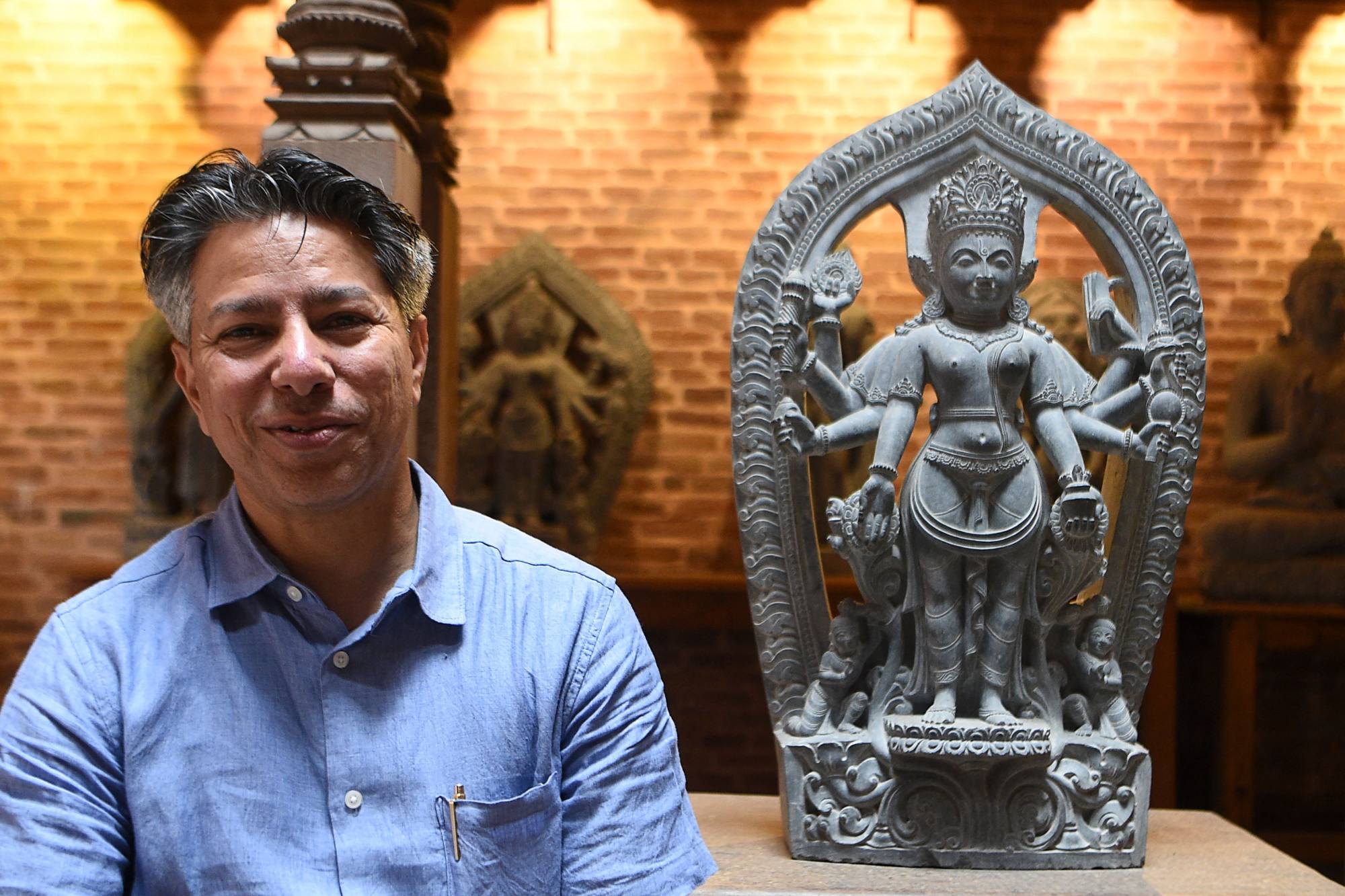
Rabindra has assembled a collection of replicas for a planned museum. Photo: AFP
In June, the Paris branch of auction house Bonhams was forced to cancel the sale of five gilded copper-bronze idols, wrenched out from the gateway of a temple in the 1970s, after pressure from Nepali officials and activists.
The auction was first spotted by Lost Art of Nepal, an anonymously-run Facebook page that has posted about hundreds of historical and religious objects, flagging their new locations from auction houses to European or American museums.
“We have seen empty temples, empty shrines, empty pedestals and torn toranas [religious arches or gateways] everywhere” in the Kathmandu valley, the page’s administrator said in an email.
“In search for answers, I have collected old photographs from … [all] possible sources,” they added. “The extent of loss of our heritage is much more than what is known or published.”
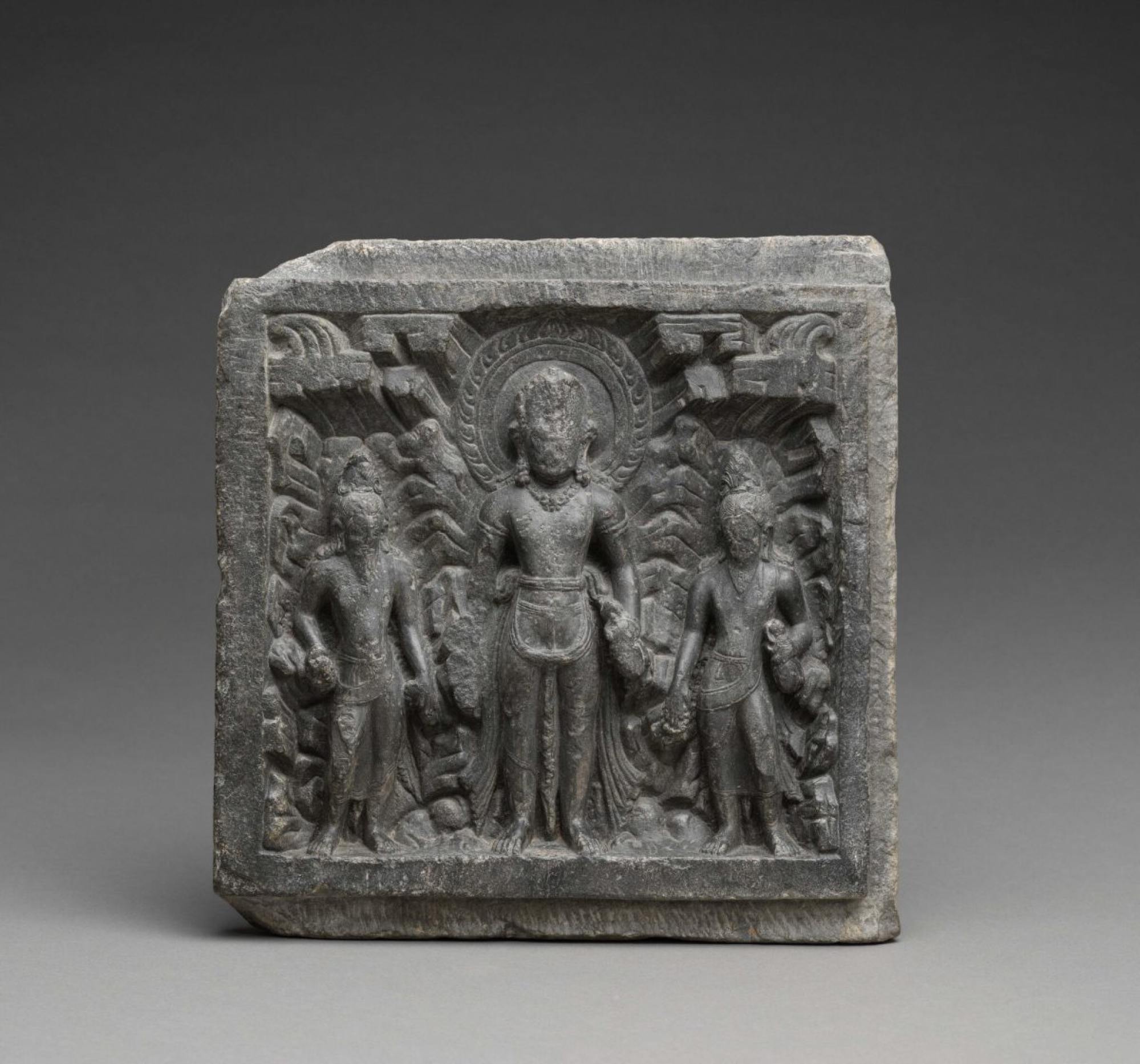
New York’s Metropolitan Museum of Art handed over a 10th-century stone sculpture of the Hindu god Shiva in September. Photo: Metropolitan Museum of Art
Campaigners want to make stolen art – thefts continue to this day, primarily from remote monasteries – as sensitive an issue among buyers and collectors as conflict diamonds or elephant ivory.
With heritage repatriation a growing issue for museums around the world – the ancient Greek Elgin Marbles and the Benin Bronzes from Nigeria are probably the best-known controversies – the occasional Nepali recovery is building into a trickle.
Six pieces have been returned this year and authorities are seeking more from France, the United States and Britain.
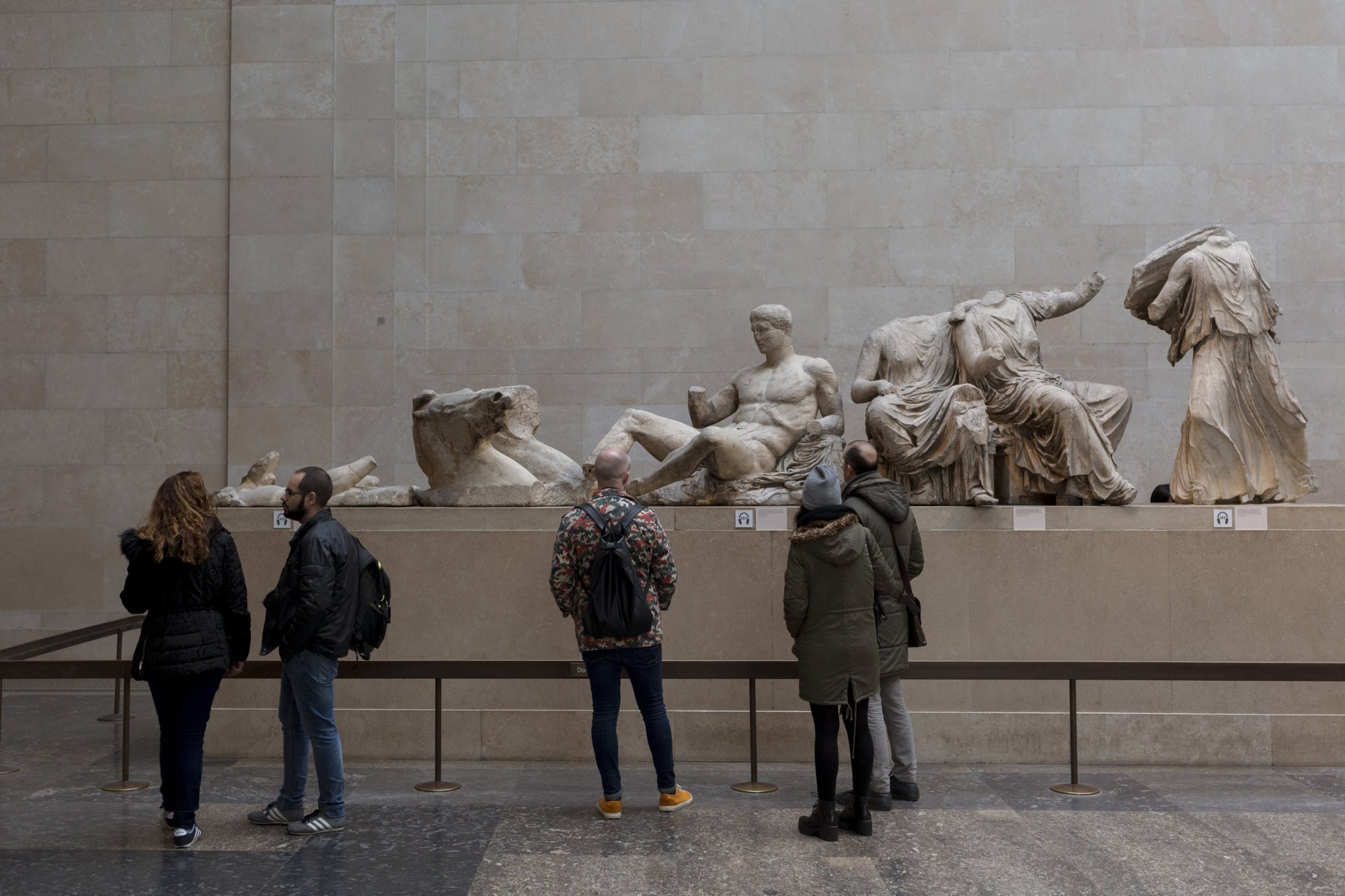
Visitors learn about the British Museum’s Elgin Marbles that originate from the Parthenon in Athens, Greece. Photo: Getty Images
In March, the Dallas Art Museum and US crime agency the FBI returned to Nepal a stolen 12th- to 15th-century androgynous stone sculpture of Hindu deities Laxmi-Narayan.
This month it will be reinstalled in its original temple location, from where it disappeared in 1984. The museum had held the statue for 30 years but a tweet by arts crime professor Erin Thompson questioning its provenance prompted an investigation.
“These are objects people were worshipping until they were ripped away from them,” she says.

A military commander sculpture looted by British soldiers from the Kingdom of Benin in 1897, at the Linden Museum in Stuttgart, Germany. Photo: Getty Images
New York’s Metropolitan Museum of Art handed over a 10th-century stone sculpture of the Hindu god Shiva in September, the third item it has repatriated to Nepal since 2018.
In Bhaktapur, devotees worship another androgynous Laxmi-Narayan idol, protected behind a locked iron gate.
Expecting mothers continue the ancient tradition of offering it oil to predict the gender of their baby. But it is a replica. The 15th-century original went missing in the early 1980s.
Badri Tuwal, 70, remembers how residents cried in mourning the day the idol disappeared. “We don’t know where it is,” he says, “but I hope someday we can celebrate its return.”
Nepalese heritage activists are campaigning to bring home some of the thousands of items stolen from temples and monasteries in the country to feed art markets
When a Nepali academic in the US saw a 17th century gold necklace from Nepal in a museum there, she wept and began to pray. ‘I had so many questions,’ she says
Agence France-Presse
Published 2 Dec, 2021

Rabindra Puri at his house in Bhaktapur, east of Kathmandu. He is one of the heritage activists campaigning to bring back from overseas museums Nepalese artefacts stolen from the country. Photo: AFP
When Virginia Tech professor Sweta Gyanu Baniya saw an ornate 17th century Nepali necklace in the Art Institute of Chicago in the United States, she burst into tears, bowed down and began to pray.
Now a video she posted on social media has made the artefact one of the latest targets for heritage activists sleuthing online to bring home some of the thousands of items whisked out over decades from the Himalayan country.
Only a handful of relics have been returned so far, but they have come from some of the world’s top cultural institutions and pressure for more is mounting.
Nepal’s then king offered the gilt copper necklace, adorned with semi-precious stones, to Taleju Bhawani, his Malla dynasty’s patron goddess, in around 1650.
‘They are gods to us’: Nepal seeks to bring home stolen artefacts from the West
Her temple in Kathmandu, the Nepalese capital, is only open to the public one day a year, but officials removed the work for safekeeping in the 1970s – after which it disappeared.
Baniya says her reaction when she visited the Chicago museum in June was “just overpowering”.

This 400-year-old necklace from Nepal is now in a museum in the United States. Photo: Art Institute of Chicago
“I started to weep in front of it,” she says. “I started to just pray normally like I would do in temple.
“I had so many questions. Like why is it here, how did it come here?”
Traces of vermilion pigment used in Hindu worship rituals are still visible on its surface, and Baniya’s Twitter video prompted Nepali authorities to contact the museum to seek its return.

Sweta Gyanu Baniya is a Virginia Tech professor. Photo: Virginia Tech
The Art Institute of Chicago did not respond to multiple requests for comment but its website states the necklace was donated by the private Alsdorf Foundation, which bought it from a California dealer in 1976.
Priest Udhav Kamacharya has served at the temple for 26 years but Baniya’s footage was the first time he had seen the relic.
As he watched, he says: “I felt that the goddess still resides here. We sometimes say the gods are not here any more, but they are. That is why it was found despite being in a foreign land.”

Priest Udhav Kamacharya has served at the Taleju Temple for 26 years. Photo: AFP
Nepal is deeply religious, and its Hindu and Buddhist temples and heritage sites remain an integral part of people’s everyday lives.
Many, though, are bereft of their centuries-old sculptures, paintings, ornamental windows and even doors, stolen – sometimes with the help of corrupt officials – after the country opened up to the outside world in the 1950s to feed art markets in the United States, Europe and elsewhere.
“Our art for us is not just art, they are gods to us,” says heritage expert Rabindra Puri, who campaigns to repatriate stolen Nepali heritage and has assembled a collection of replicas for a planned museum on the issue.

Rabindra has assembled a collection of replicas for a planned museum. Photo: AFP
In June, the Paris branch of auction house Bonhams was forced to cancel the sale of five gilded copper-bronze idols, wrenched out from the gateway of a temple in the 1970s, after pressure from Nepali officials and activists.
The auction was first spotted by Lost Art of Nepal, an anonymously-run Facebook page that has posted about hundreds of historical and religious objects, flagging their new locations from auction houses to European or American museums.
“We have seen empty temples, empty shrines, empty pedestals and torn toranas [religious arches or gateways] everywhere” in the Kathmandu valley, the page’s administrator said in an email.
“In search for answers, I have collected old photographs from … [all] possible sources,” they added. “The extent of loss of our heritage is much more than what is known or published.”

New York’s Metropolitan Museum of Art handed over a 10th-century stone sculpture of the Hindu god Shiva in September. Photo: Metropolitan Museum of Art
Campaigners want to make stolen art – thefts continue to this day, primarily from remote monasteries – as sensitive an issue among buyers and collectors as conflict diamonds or elephant ivory.
With heritage repatriation a growing issue for museums around the world – the ancient Greek Elgin Marbles and the Benin Bronzes from Nigeria are probably the best-known controversies – the occasional Nepali recovery is building into a trickle.
Six pieces have been returned this year and authorities are seeking more from France, the United States and Britain.

Visitors learn about the British Museum’s Elgin Marbles that originate from the Parthenon in Athens, Greece. Photo: Getty Images
In March, the Dallas Art Museum and US crime agency the FBI returned to Nepal a stolen 12th- to 15th-century androgynous stone sculpture of Hindu deities Laxmi-Narayan.
This month it will be reinstalled in its original temple location, from where it disappeared in 1984. The museum had held the statue for 30 years but a tweet by arts crime professor Erin Thompson questioning its provenance prompted an investigation.
“These are objects people were worshipping until they were ripped away from them,” she says.

A military commander sculpture looted by British soldiers from the Kingdom of Benin in 1897, at the Linden Museum in Stuttgart, Germany. Photo: Getty Images
New York’s Metropolitan Museum of Art handed over a 10th-century stone sculpture of the Hindu god Shiva in September, the third item it has repatriated to Nepal since 2018.
In Bhaktapur, devotees worship another androgynous Laxmi-Narayan idol, protected behind a locked iron gate.
Expecting mothers continue the ancient tradition of offering it oil to predict the gender of their baby. But it is a replica. The 15th-century original went missing in the early 1980s.
Badri Tuwal, 70, remembers how residents cried in mourning the day the idol disappeared. “We don’t know where it is,” he says, “but I hope someday we can celebrate its return.”
No comments:
Post a Comment